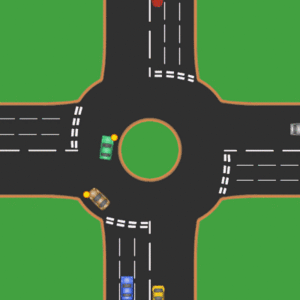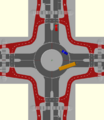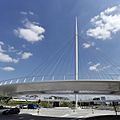Roundabout facts for kids

A roundabout is a special type of road intersection that helps traffic move smoothly and safely. Instead of traffic lights or stop signs, roundabouts are circular intersections where drivers travel in one direction around a central island. They are designed to keep cars flowing and reduce the chance of serious crashes.
Roundabouts are also sometimes called traffic circles or traffic islands. They are used all over the world to manage busy roads and make driving easier for everyone.
Contents
How Roundabouts Work
Understanding how to use a roundabout is quite simple, but the rules can be a little different depending on where you live. The main idea is to "give way" to traffic already in the circle.
Driving on the Left
In countries where people drive on the left side of the road, like the United Kingdom or Australia:
- When you get to the roundabout, you must let any traffic coming from your right go first. This means you wait for a safe gap in the traffic.
- Once it's safe, you enter the roundabout and drive around the central island in a clockwise direction.
Driving on the Right
In countries where people drive on the right side of the road, like the United States or France:
- When you arrive at the roundabout, you must let any traffic coming from your left go first. Wait until there is a clear space for you to enter.
- After entering, you drive around the central island in an anticlockwise direction.
Giving Way and Safety
The "give way" rule is very important. It means that drivers already inside the roundabout have the right-of-way. This helps prevent crashes because everyone knows who should go first. Roundabouts are often safer than traditional intersections with traffic lights because they encourage slower speeds and reduce the types of crashes that cause serious injuries.
Benefits of Roundabouts
Roundabouts offer several advantages for drivers, cyclists, and pedestrians. They are designed to improve traffic flow and safety.
Safer Roads
One of the biggest benefits of roundabouts is safety. They reduce the number of places where cars might crash into each other at high speeds. Instead of T-bone crashes (where one car hits the side of another), roundabouts usually lead to less severe side-swipe or rear-end collisions if crashes happen at all. This is because drivers slow down when approaching and entering the circle.
Smoother Traffic Flow
Roundabouts help traffic move more efficiently. Because cars don't have to stop completely at a red light, traffic can keep moving, even if slowly. This reduces delays and can make your journey quicker, especially during busy times. It also means less idling, which can be better for the environment.
Better for the Environment
Since cars spend less time stopping and starting, roundabouts can help reduce fuel use and air pollution. When engines are idling at traffic lights, they burn fuel and release emissions. Roundabouts keep cars moving, which can lead to less pollution overall.
Types of Roundabouts
Not all roundabouts look the same. Some are very small, while others are huge and complex.
Mini-Roundabouts
A mini-roundabout is a very small roundabout, often just a painted circle on the road instead of a raised island. They are used in places where there isn't much space, like residential streets. Drivers still follow the same give-way rules, but they can sometimes drive over the painted circle if their vehicle is too large to go around it.
Multi-Lane Roundabouts
Some roundabouts have more than one lane. These are called multi-lane roundabouts. Drivers need to choose the correct lane before entering, depending on which exit they want to take. Signs and road markings usually guide drivers on how to use these larger roundabouts.
Magic Roundabouts
A Magic Roundabout is a very unusual and complex type of roundabout, like the famous one in Swindon, UK. It's actually a large central roundabout surrounded by several smaller mini-roundabouts. It can look confusing, but it's designed to keep a lot of traffic moving in a small area.
History of Roundabouts
The idea of circular intersections has been around for a long time.
The very first traffic circle in the United States was built in 1905 in New York City. In the United Kingdom, the first roundabout was built in 1909 in Letchworth Garden City. Early designs were not always as safe or efficient as modern roundabouts. Over time, engineers learned how to design them better, leading to the safer and smoother roundabouts we see today.
Famous Roundabouts
Some roundabouts are famous landmarks.
One of the most well-known is the Place Charles de Gaulle, Etoile in Paris, France. This huge traffic circle surrounds the famous Arc de Triomphe. Twelve avenues meet at this roundabout, forming a star shape, which is why it's called "Etoile," meaning "star" in French. It's a very busy and impressive roundabout!
Images for kids
-
The Hotel Indonesia Roundabout in Jakarta, Indonesia
-
The United Kingdom's first roundabout (1909) in Letchworth Garden City
-
One famous roundabout is the Place Charles de Gaulle, Etoile, where 12 avenues come together, drawing a star, which explains the word "étoile", star in French. In the middle of the roundabout is the Arc de Triomphe.
-
A fountain dominates this roundabout in Aix-en-Provence, France.
-
This roundabout in Shanghai, China, has a pedestrian bridge in the form of another, raised roundabout.
-
A small roundabout in Waterloo, Ontario, Canada
-
Small roundabout in Kargilik, Xinjiang, China
-
A hybrid raindrop roundabout in Zagreb, Croatia, 45°48′33″N 15°59′55″E / 45.809296°N 15.998648°E. These two roundabouts are more akin to a "magic roundabout" since the left turns need not drive through both of them.
-
Haymarket roundabout, Melbourne
-
The Main North Line railway bisects the State Highway 1/Main Street roundabout in Blenheim, New Zealand.
-
National Register of Historic Places plaque on the first traffic circle in the United States, at the intersection of River and Pleasant streets in Yarmouth, Massachusetts
-
Traffic ten abreast traverses the Place de l'Étoile. This traffic circle surrounds the Arc de Triomphe at the intersection of ten two-way and two one-way streets. It has no lane markings.
-
Roundabout, Haarlem, Netherlands, 1990. Cyclists may also be users of a roundabout.
-
Roundabout signs in Linköping, Sweden
-
Roundabout in the centre of Colombo, Sri Lanka
-
Double-lane Raindrop Fountain Roundabout in Zenica, Bosnia and Herzegovina, where roundabouts replaced all traffic lights since 2011.
-
Pavement markings invite cyclists to enter sidewalk on approach to roundabout in Mesa, Arizona. Cyclists are still permitted to use the roundabout like any other vehicle.
See also
 In Spanish: Rotonda para niños
In Spanish: Rotonda para niños



































